Abstract
A putative synthetic vaccine for foot-and-mouth disease (FMDV15) has proved less successful in a host species, cattle, than predicted by results in a small-animal model. Possible reasons for this include non-recognition by T cells influenced by major histocompatibility complex (MHC)-linked immune response gene control. It is now possible to type for human leucocyte antigen (HLA) DR-like bovine MHC (BoLA) class II polymorphisms with a one-dimensional isoelectric focusing (IEF) technique. Using this method 14 unrelated cattle were selected with eight different BoLA class II IEF types. After immunization with FMDV15, 13 cattle generated a T-cell response to FMDV15. However, the fine specificity and magnitude of the response was related to BoLA class II type. The non-response by one animal and low response by two other animals were associated with two of the BoLA class II types. Response to the region 149-158 was immunodominant and animals which did not respond to this region had low responses to the whole peptide. Using FMDV-specific T-cell lines five BoLA class II types associated with responder animals were able to present FMDV15 in an MHC class II-restricted fashion, indicating that this peptide is capable of binding to different MHC class II molecules and may account for the broad response observed. The restriction patterns of the lines indicated that the IEF method does not distinguish all functional polymorphisms. At least two of the IEF-defined types could each be split into two distinct specificities and revealed that the three sets of animals with identical IEF types in fact expressed distinct restriction elements.
Full text
PDF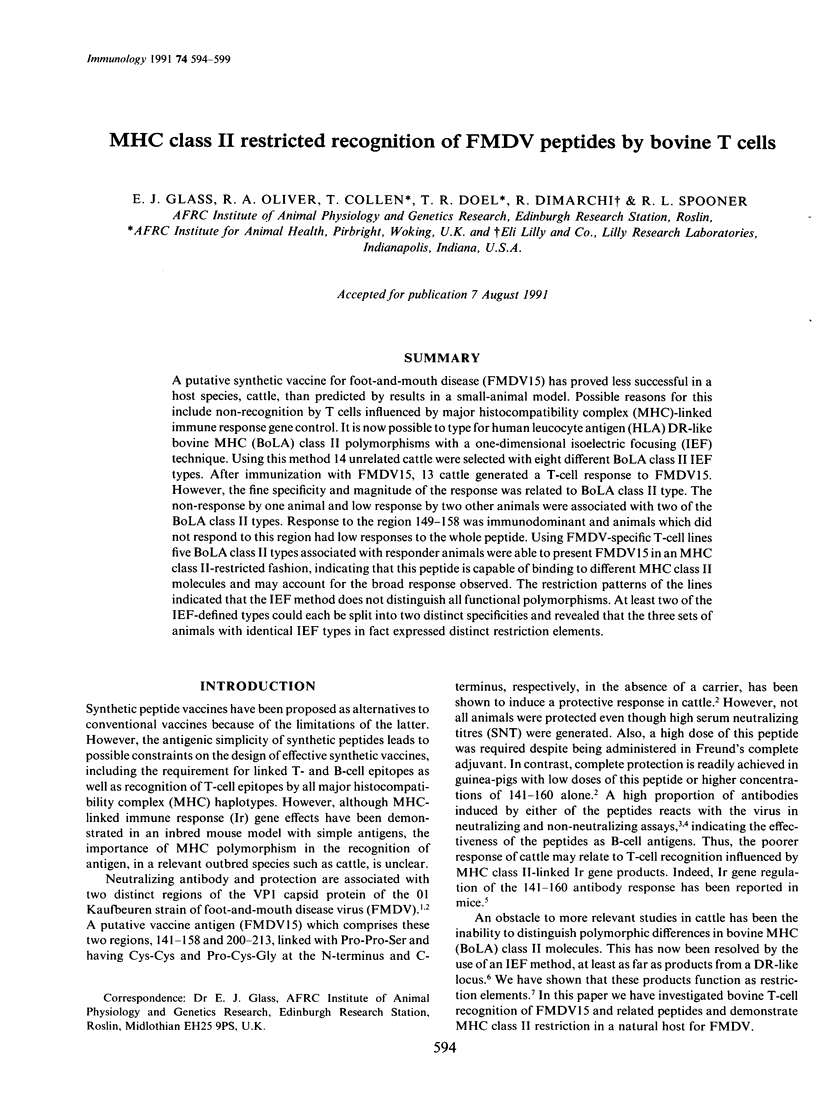

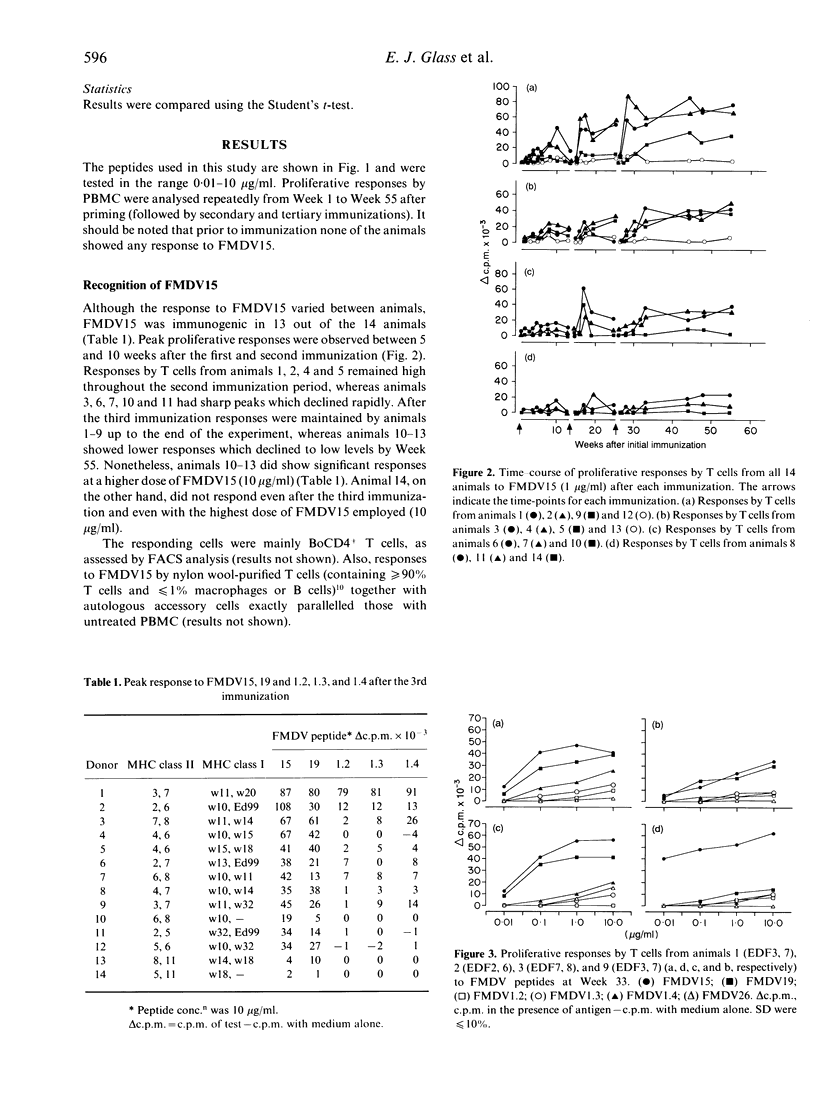
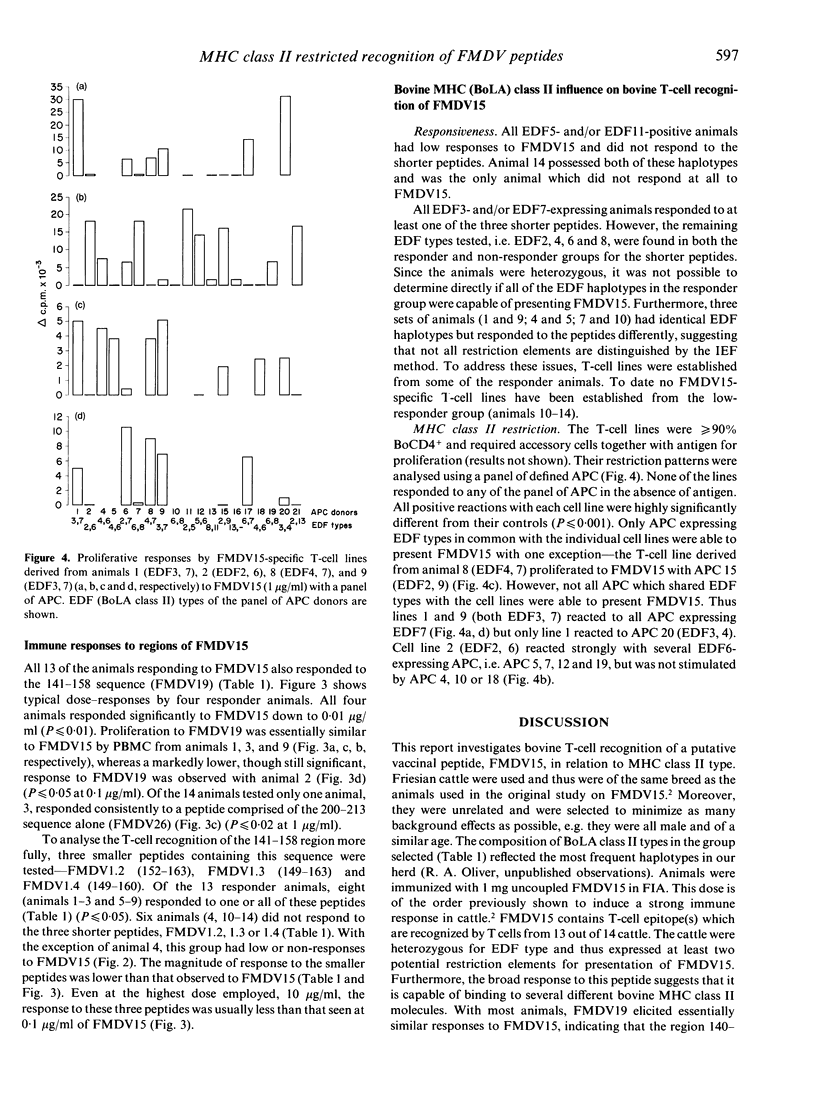
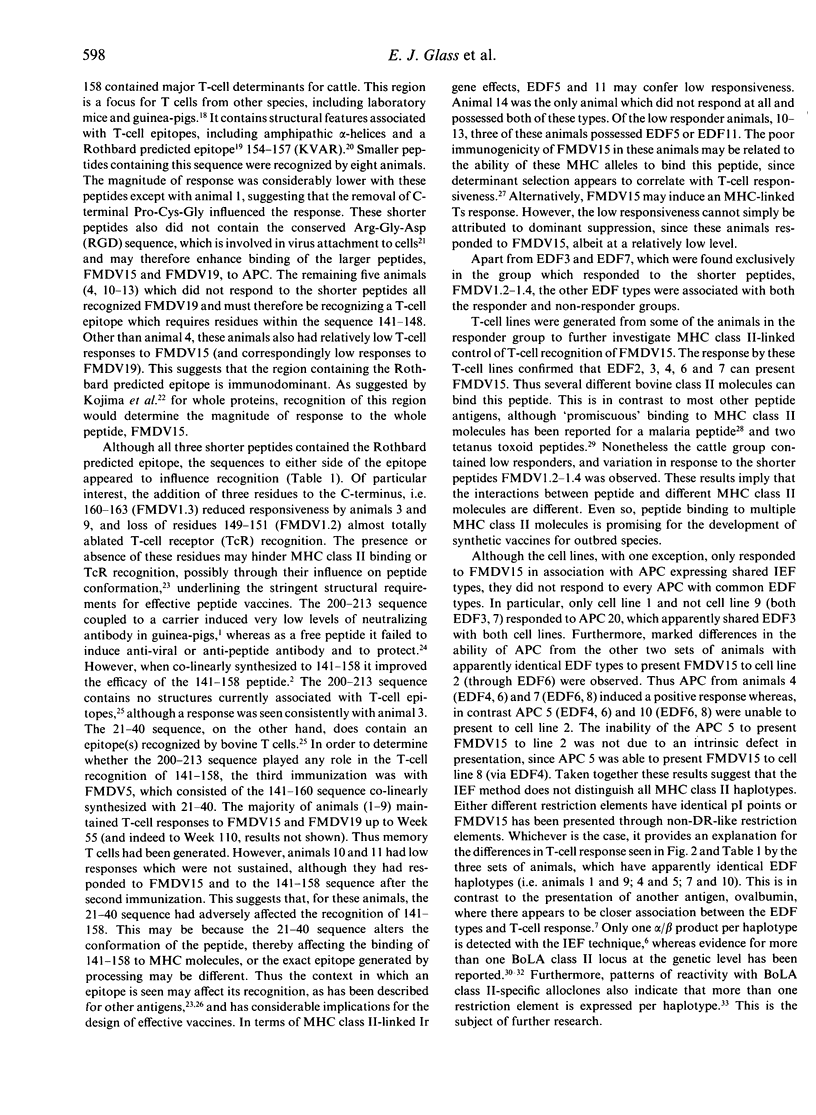
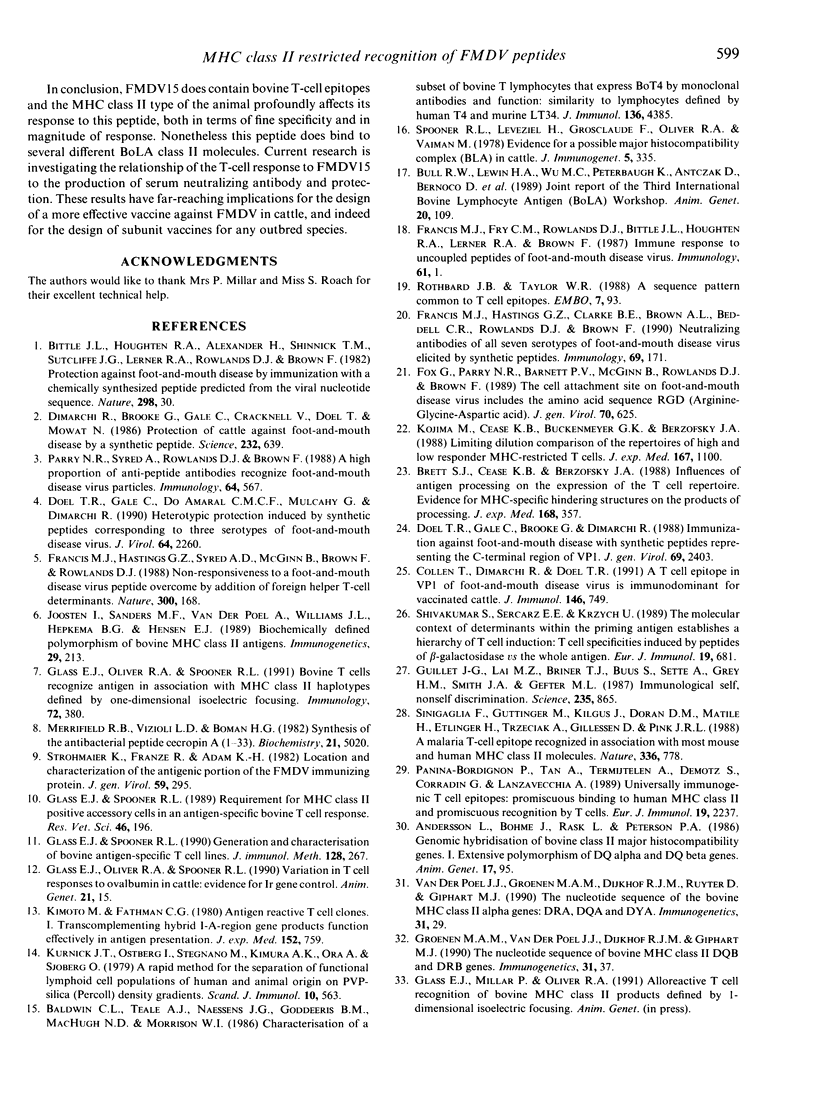
Selected References
These references are in PubMed. This may not be the complete list of references from this article.
- Andersson L., Böhme J., Rask L., Peterson P. A. Genomic hybridization of bovine class II major histocompatibility genes: 1. Extensive polymorphism of DQ alpha and DQ beta genes. Anim Genet. 1986;17(2):95–112. doi: 10.1111/j.1365-2052.1986.tb00731.x. [DOI] [PubMed] [Google Scholar]
- Baldwin C. L., Teale A. J., Naessens J. G., Goddeeris B. M., MacHugh N. D., Morrison W. I. Characterization of a subset of bovine T lymphocytes that express BoT4 by monoclonal antibodies and function: similarity to lymphocytes defined by human T4 and murine L3T4. J Immunol. 1986 Jun 15;136(12):4385–4391. [PubMed] [Google Scholar]
- Bittle J. L., Houghten R. A., Alexander H., Shinnick T. M., Sutcliffe J. G., Lerner R. A., Rowlands D. J., Brown F. Protection against foot-and-mouth disease by immunization with a chemically synthesized peptide predicted from the viral nucleotide sequence. Nature. 1982 Jul 1;298(5869):30–33. doi: 10.1038/298030a0. [DOI] [PubMed] [Google Scholar]
- Brett S. J., Cease K. B., Berzofsky J. A. Influences of antigen processing on the expression of the T cell repertoire. Evidence for MHC-specific hindering structures on the products of processing. J Exp Med. 1988 Jul 1;168(1):357–373. doi: 10.1084/jem.168.1.357. [DOI] [PMC free article] [PubMed] [Google Scholar]
- Bull R. W., Lewin H. A., Wu M. C., Peterbaugh K., Antczak D., Bernoco D., Cwik S., Dam L., Davies C., Dawkins R. L. Joint report of the Third International Bovine Lymphocyte Antigen (BoLA) Workshop, Helsinki, Finland, 27 July 1986. Anim Genet. 1989;20(1):109–132. doi: 10.1111/j.1365-2052.1989.tb00849.x. [DOI] [PubMed] [Google Scholar]
- Collen T., Dimarchi R., Doel T. R. A T cell epitope in VP1 of foot-and-mouth disease virus is immunodominant for vaccinated cattle. J Immunol. 1991 Jan 15;146(2):749–755. [PubMed] [Google Scholar]
- DiMarchi R., Brooke G., Gale C., Cracknell V., Doel T., Mowat N. Protection of cattle against foot-and-mouth disease by a synthetic peptide. Science. 1986 May 2;232(4750):639–641. doi: 10.1126/science.3008333. [DOI] [PubMed] [Google Scholar]
- Doel T. R., Gale C., Brooke G., DiMarchi R. Immunization against foot-and-mouth disease with synthetic peptides representing the C-terminal region of VP1. J Gen Virol. 1988 Sep;69(Pt 9):2403–2406. doi: 10.1099/0022-1317-69-9-2403. [DOI] [PubMed] [Google Scholar]
- Doel T. R., Gale C., Do Amaral C. M., Mulcahy G., Dimarchi R. Heterotypic protection induced by synthetic peptides corresponding to three serotypes of foot-and-mouth disease virus. J Virol. 1990 May;64(5):2260–2264. doi: 10.1128/jvi.64.5.2260-2264.1990. [DOI] [PMC free article] [PubMed] [Google Scholar]
- Fox G., Parry N. R., Barnett P. V., McGinn B., Rowlands D. J., Brown F. The cell attachment site on foot-and-mouth disease virus includes the amino acid sequence RGD (arginine-glycine-aspartic acid). J Gen Virol. 1989 Mar;70(Pt 3):625–637. doi: 10.1099/0022-1317-70-3-625. [DOI] [PubMed] [Google Scholar]
- Francis M. J., Fry C. M., Rowlands D. J., Bittle J. L., Houghten R. A., Lerner R. A., Brown F. Immune response to uncoupled peptides of foot-and-mouth disease virus. Immunology. 1987 May;61(1):1–6. [PMC free article] [PubMed] [Google Scholar]
- Francis M. J., Hastings G. Z., Clarke B. E., Brown A. L., Beddell C. R., Rowlands D. J., Brown F. Neutralizing antibodies to all seven serotypes of foot-and-mouth disease virus elicited by synthetic peptides. Immunology. 1990 Feb;69(2):171–176. [PMC free article] [PubMed] [Google Scholar]
- Glass E. J., Oliver R. A., Spooner R. L. Bovine T cells recognize antigen in association with MHC class II haplotypes defined by one-dimensional isoelectric focusing. Immunology. 1991 Mar;72(3):380–385. [PMC free article] [PubMed] [Google Scholar]
- Glass E. J., Oliver R. A., Spooner R. L. Variation in T cell responses to ovalbumin in cattle: evidence for Ir gene control. Anim Genet. 1990;21(1):15–28. doi: 10.1111/j.1365-2052.1990.tb03203.x. [DOI] [PubMed] [Google Scholar]
- Glass E. J., Spooner R. L. Generation and characterisation of bovine antigen-specific T cell lines. J Immunol Methods. 1990 Apr 17;128(2):267–275. doi: 10.1016/0022-1759(90)90219-l. [DOI] [PubMed] [Google Scholar]
- Glass E. J., Spooner R. L. Requirement for MHC class II positive accessory cells in an antigen specific bovine T cell response. Res Vet Sci. 1989 Mar;46(2):196–201. [PubMed] [Google Scholar]
- Groenen M. A., van der Poel J. J., Dijkhof R. J., Giphart M. J. The nucleotide sequence of bovine MHC class II DQB and DRB genes. Immunogenetics. 1990;31(1):37–44. doi: 10.1007/BF00702487. [DOI] [PubMed] [Google Scholar]
- Guillet J. G., Lai M. Z., Briner T. J., Buus S., Sette A., Grey H. M., Smith J. A., Gefter M. L. Immunological self, nonself discrimination. Science. 1987 Feb 20;235(4791):865–870. doi: 10.1126/science.2433769. [DOI] [PubMed] [Google Scholar]
- Joosten I., Sanders M. F., van der Poel A., Williams J. L., Hepkema B. G., Hensen E. J. Biochemically defined polymorphism of bovine MHC class II antigens. Immunogenetics. 1989;29(3):213–216. doi: 10.1007/BF00373649. [DOI] [PubMed] [Google Scholar]
- Kimoto M., Fathman C. G. Antigen-reactive T cell clones. I. Transcomplementing hybrid I-A-region gene products function effectively in antigen presentation. J Exp Med. 1980 Oct 1;152(4):759–770. doi: 10.1084/jem.152.4.759. [DOI] [PMC free article] [PubMed] [Google Scholar]
- Kojima M., Cease K. B., Buckenmeyer G. K., Berzofsky J. A. Limiting dilution comparison of the repertoires of high and low responder MHC-restricted T cells. J Exp Med. 1988 Mar 1;167(3):1100–1113. doi: 10.1084/jem.167.3.1100. [DOI] [PMC free article] [PubMed] [Google Scholar]
- Kurnick J. T., Ostberg L., Stegagno M., Kimura A. K., Orn A., Sjöberg O. A rapid method for the separation of functional lymphoid cell populations of human and animal origin on PVP-silica (Percoll) density gradients. Scand J Immunol. 1979;10(6):563–573. doi: 10.1111/j.1365-3083.1979.tb01391.x. [DOI] [PubMed] [Google Scholar]
- Merrifield R. B., Vizioli L. D., Boman H. G. Synthesis of the antibacterial peptide cecropin A (1-33). Biochemistry. 1982 Sep 28;21(20):5020–5031. doi: 10.1021/bi00263a028. [DOI] [PubMed] [Google Scholar]
- Panina-Bordignon P., Tan A., Termijtelen A., Demotz S., Corradin G., Lanzavecchia A. Universally immunogenic T cell epitopes: promiscuous binding to human MHC class II and promiscuous recognition by T cells. Eur J Immunol. 1989 Dec;19(12):2237–2242. doi: 10.1002/eji.1830191209. [DOI] [PubMed] [Google Scholar]
- Parry N. R., Syred A., Rowlands D. J., Brown F. A high proportion of anti-peptide antibodies recognize foot-and-mouth disease virus particles. Immunology. 1988 Aug;64(4):567–572. [PMC free article] [PubMed] [Google Scholar]
- Rothbard J. B., Taylor W. R. A sequence pattern common to T cell epitopes. EMBO J. 1988 Jan;7(1):93–100. doi: 10.1002/j.1460-2075.1988.tb02787.x. [DOI] [PMC free article] [PubMed] [Google Scholar]
- Shivakumar S., Sercarz E. E., Krzych U. The molecular context of determinants within the priming antigen establishes a hierarchy of T cell induction: T cell specificities induced by peptides of beta-galactosidase vs. the whole antigen. Eur J Immunol. 1989 Apr;19(4):681–687. doi: 10.1002/eji.1830190417. [DOI] [PubMed] [Google Scholar]
- Sinigaglia F., Guttinger M., Kilgus J., Doran D. M., Matile H., Etlinger H., Trzeciak A., Gillessen D., Pink J. R. A malaria T-cell epitope recognized in association with most mouse and human MHC class II molecules. Nature. 1988 Dec 22;336(6201):778–780. doi: 10.1038/336778a0. [DOI] [PubMed] [Google Scholar]
- Strohmaier K., Franze R., Adam K. H. Location and characterization of the antigenic portion of the FMDV immunizing protein. J Gen Virol. 1982 Apr;59(Pt 2):295–306. doi: 10.1099/0022-1317-59-2-295. [DOI] [PubMed] [Google Scholar]
- van der Poel J. J., Groenen M. A., Dijkhof R. J., Ruyter D., Giphart M. J. The nucleotide sequence of the bovine MHC class II alpha genes: DRA, DOA, and DYA. Immunogenetics. 1990;31(1):29–36. doi: 10.1007/BF00702486. [DOI] [PubMed] [Google Scholar]


